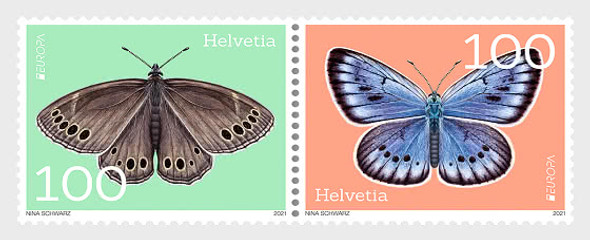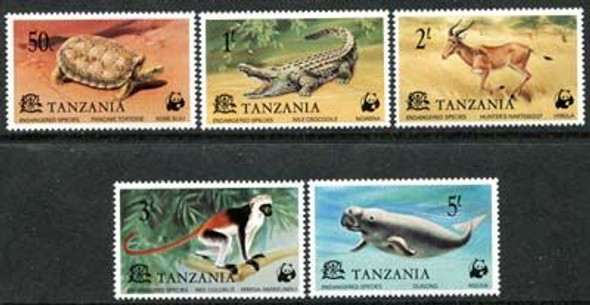ENDANGERED SPECIES of Azores & Madeira (2023)-Insects & Reptiles (6v)- Butterfly, snail, frog, lizard, etc.
- SKU:
- 1123_azo 122
Description
Located in the North Atlantic Ocean, the Azores archipelago is composed of nine islands of volcanic origin. Together with Madeira, the Canary Islands and Cape Verde, the Azores form part of the Macaronesian biogeographical region, an important world biodiversity hotspot which includes the Laurisilva Forest. The Azores have a geological, architectural, cultural and immaterial heritage of immense value. Its islands are an award-winning "sustainable tourism destination" offering unforgettable natural experiences focused on the preservation of its natural heritage rich in biological diversity, with a total number of species and subspecies estimated at 11,347, of which 7830 (69%) are terrestrial and freshwater species, including 580 unique endemic species.
This philatelic issue features four representatives of Azorean terrestrial fauna from three different groups: arthropods, molluscs and birds.
Terrestrial arthropods are the most diverse group of invertebrates in the archipelago, with a total of 2420 species and subspecies, 1854 of which are insects, 42 are myriapods, 92 are crustaceans and 329 are arachnids, including 133 spiders (such as the endemic Azorean wolf spider, Pardosa acorensis). Insects include 585 beetles, 428 flies, 338 true bugs, 163 hymenoptera species and 159 butterflies and moths (including the endemic cabbage butterfly, Pieris brassicae azorensis). Their distribution over the various islands is uneven, being found in greater numbers on the larger islands (São Miguel, Terceira and Pico). To date, a remarkable count of 276 endemic species and subspecies of arthropods, along with an additional 793 native non-endemic species, have been documented in the Azores.
Molluscs are another large and highly endemic group in the Azores. Of the 126 terrestrial, freshwater and halophilous mollusc species, 53 (42%) are endemic (such as the São Miguel snail, Oxychilus volutella). Due to its greater geological age, the small island of Santa Maria shelters 21 endemic species, seventeen of which are exclusive to the island. This richness of endemic species in the Azorean malacofauna is scientifically important, making the archipelago a natural laboratory where evolutionary processes can be studied in real time.
The inland water bodies are host to several aquatic species of the Oligochaeta and Acari classes and of the Copepoda subclass, as well as several arthropods of the Diptera, Coleoptera, Heteroptera, Trichoptera and Odonata orders. We note in particular the "crown jewel" of the Azorean dragonflies, Ischnura hastata, whose populations made up exclusively by females are a unique example in the world of parthenogenetic reproduction.
Terrestrial vertebrates are estimated to number 71 resident species and subspecies. Of these, birds are the most important group, represented by 37 regular breeding species and subspecies and several migratory species. The population abundance of terrestrial birds varies according to the habitats and elevations. There are twelve endemic species and subspecies, including the Azores bullfinch, Pyrrhula murina, a passerine bird that nests in the Laurisilva forest in eastern São Miguel, as well as the common starling, Sturnus vulgaris granti. There are only two resident predatory birds: the kite and the owl. Around twenty mammals belonging to the orders Carnivora, Chiroptera, Rodentia, Lagomorpha, Insectivora and Ungulata are known on the islands. With the exception of the endemic Azores bat Nictalus azoreum, observable during the day, the species of the remaining orders are of anthropogenic introduction. There are also five indigenous domestic animal breeds, including two dogs (the São Miguel Cattle Dog and the Barbado da Terceira), two equines (the Dwarf Donkey of Graciosa Island and the Terceira Pony), and a bovine (Ramo Grande). There are two amphibians (the green frog and Northern crested newt), two reptiles (the Madeiran wall lizard and the gecko) and thirteen freshwater fish – all introduced, with the exception of the eel.
Virgílio Vieira | Paulo A. V. Borges cE3c – Azorean Biodiversity Group University of the Azores
MADEIRA
Considered a biodiversity hotspot of the Atlantic Ocean, the islands of the Madeira archipelago have a highly valuable Natural Heritage. The archipelago belongs to the Macaronesian biogeographical region, with a great number of endemic species, rich habitats, and a large diversity of terrestrial and marine species. More than 7000 species and subspecies of fungi, plants and terrestrial animals have been identified on the islands, 1200 of which can only be found there.
Boettger’s wall gecko or Selvagens wall gecko
Tarentola bischoffi
This subspecies of Boettger’s wall gecko is a crepuscular and nocturnal reptile indigenous to the Savage islands and can be found in all three islands: Selvagem Grande, Selvagem Pequena and Ilhéu de Fora. On Selvagem Grande island, it can be found at sea level and along the cliffs in small numbers, up to the central plateau in greater abundance. It is frequently spotted in dry stony areas and in scrublands, feeding on insects. Its breeding season is in spring, between April and July, and some pregnant females can still be found in August. It is classified as Vulnerable (VU) in the Red Book of Vertebrates in Portugal, because it has a very restricted distribution and is concentrated in only three populations, two of which on very low islands, thus vulnerable to sea level rise (Selvagem Pequena and Ilhéu de Fora).
Madeiran land snail
Discula lyelliana
Discula lyelliana is a species of land snail endemic to the Deserta islands, with only one population known in nature. It occurs in an area of undergrowth in Deserta Grande and can be found under rocks or around the stems of the common fern. This snail is active mostly during the night, when humidity is generally higher, and can be found wandering among the stones and leaf litter. As detritivores, they feed on dead animal and plant matter present in the soil. Predation by domestic rats and the loss and degradation of its habitat by roaming goats are, along with its low population and reduced distribution area, the main threats to the conservation of this species, which is considered Critically Endangered (CR).
Madeiran wall lizard
Teira dugesii
The omnivorous Madeiran wall lizard can be found in almost all types of terrestrial habitats on Madeira island, from the sea coast up to the highest mountains. This lizard can grow to a full length of up to 20 cm, and its colour varies from light brown to dark grey. Some specimens (usually males) may show iridescent colours, such as green, blue and violet.
Deserta Grande wolf spider
Hogna ingens
This spider is endemic to Vale da Castanheira on the most northern point of Deserta Grande, one of three Desertas islands in the Madeira archipelago. The Deserta Grande wolf spider can grow to a size of 4 cm in body length, with a 12 cm leg span. Its habitat is characterised by open ground with crevices and holes where it can hide, but it has been losing range in recent years. The estimated number of adult specimens is 4000, which makes it one of the rarest wolf spiders in the world, listed as Critically Endangered (CR) by IUCN.
Since there are no indigenous terrestrial mammals in Vale da Castanheira, this species is one of the main predators in its small distribution area. It preys mostly on smaller spiders and other invertebrates, though adult animals have been observed attacking young lizards.
Institute for Nature
Conservation and Forests
















